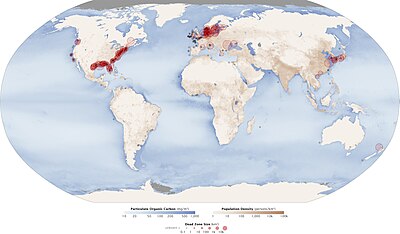Dead zone (ecology)
Dead zones are hypoxic (low-oxygen) areas in the world's oceans and large lakes.
Hypoxia occurs when dissolved oxygen (DO) concentration falls to or below 2 ml of O2/liter. Once DO falls below 0.5 ml O2/liter in a body of water, everything dies. With such low concentration of DO, the water does not support the aquatic life living there.

In March 2004 the newly established UN Environment Programme published its first Global Environment Outlook Year Book (GEO Year Book 2003). It said there were 146 dead zones in the world's oceans. In these zones marine life could not live due to low oxygen levels. Some of these zones were as small as a square kilometer (0.4 mi2), but the largest dead zone covered 70,000 square kilometers (27,000 mi2). A 2008 study counted 405 dead zones worldwide.[1]
References change
- ↑ NOAA: Gulf of Mexico 'dead zone' predictions feature uncertainty. National Oceanic and Atmospheric Administration (NOAA). June 21, 2012.